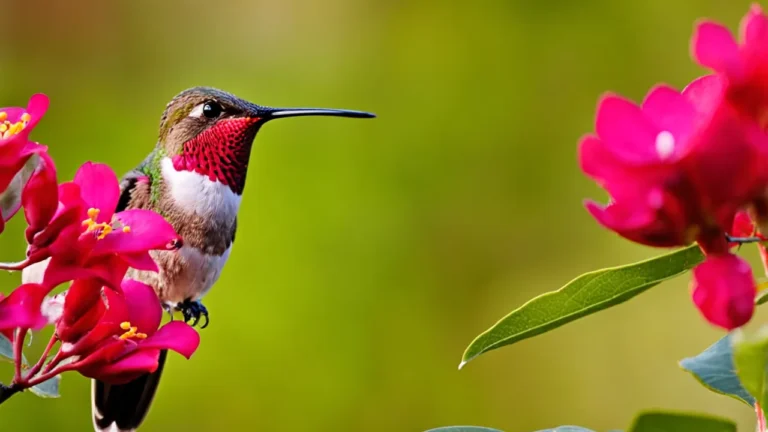Among the most intriguing animals on the earth are hummingbirds. They can easily hover and dart through the air because to their small bodies and fast metabolism. Given its intense energy requirements, one may ask how many calories a hummingbird really needs to remain in the air.
For those with limited time, the following is a brief response to your inquiry: A hummingbird needs three to seven thousand calories a day on average.
This thorough tutorial will examine the amazing caloric requirements of hummingbirds. We’ll examine how their very high energy needs are influenced by their fast pulse rates, hovering flying, and frigid surroundings. You will discover how much nectar and insects hummingbirds need to survive.
We’ll also contrast the calorie consumption of humans and other animals with that of hummingbirds. You’ll have a profound comprehension of why hummingbirds have such enormous appetites at the end.
The Exceptional Hummingbird Metabolism
Hummingbirds are amazing birds of prey, distinguished by their vivid colors and amazing hovering skills. Their very high metabolism is one of these little birds’ most amazing features. With the fastest metabolic rate of any animal on the earth, hummingbirds are able to accomplish amazing feats of flying while using an incredible amount of energy.
Accelerated heart rate
The hummingbird’s quick heartbeat contributes to its high energy requirements. A hummingbird’s heart may beat up to 1,200 times per minute, although most birds have a resting heart rate of around 400 beats per minute.
Their quick heartbeat guarantees that oxygen reaches their muscles effectively, allowing them to maintain their fast wingbeats while in flight.
Flying in Hover
The only birds that can fly in a continuous hover are hummingbirds. This special talent needs a tremendous amount of energy. A hummingbird’s wings must beat at an incredible pace of 50 to 80 times per second in order for it to remain suspended in midair.
Their little bodies are strained by this continual mobility, which uses a lot of energy. To power their flight, hummingbirds may really eat up to double their body weight in nectar and insects each day.
Modifications to Conserve Energy
Hummingbirds have developed a number of adaptations to help them save energy while having high energy requirements. Their capacity to go into a condition of torpor, which is comparable to hibernating, is one such adaptation.
A hummingbird’s metabolic rate drastically lowers during torpor, enabling it to store energy while at rest. This adaptability is particularly crucial at night, when food supplies could be limited.
Their compact stature is another adaption that saves energy. Due to their high body temperature and quick metabolism, hummingbirds produce a lot of heat. Because of their tiny size, they are able to disperse this heat more effectively, which lowers the energy required to cool their bodies.
Furthermore, because of their tiny size, they can reach nectar from blooms that bigger birds cannot, providing them with a special kind of sustenance.
Calories Derived from Honey
Hummingbirds are renowned for having extraordinary energy and agility, and maintaining their high metabolic rate is largely dependent on their nutrition. Hummingbirds mostly get their energy from the nectar of flowers.
The delicious liquid nectar, which is high in carbs, gives these little birds the energy they need to live.
Quantity of Nectar Ingested
Hummingbirds may eat up to their full weight in nectar in a single day, which is an amazing feeding rate. Hummingbirds may ingest a significant quantity of nectar, given that their usual weight is between 3 and 4 grams.
They can easily gather nectar from flowers by reaching deep into them because to their long, specialized tongues and beaks.
The Calories in Sugar
Depending on the kind of plant and the amount of sugar present, nectar may have varying amounts of calories. Nectar typically has two to three calories per milliliter. Although this may not seem like much, it gives hummingbirds a substantial amount of energy given their tiny stature.
Fun Fact: To put that in perspective, a person would need to drink almost 200 liters of nectar a day to have the same caloric density as a hummingbird!
Calories Inhaled
Despite consuming a significant quantity of nectar, hummingbirds’ bodies do not absorb all of the calories. As much as 95% of the calories in nectar may be absorbed by hummingbirds, according to research, making them very effective at obtaining energy from their diet.
Were You Aware? Insects and spiders are a great way for hummingbirds to add extra protein and nutrients to their diet, which nectar alone may not be able to give.
The Calories Insects Provide
Because of their quick metabolism and high energy levels, hummingbirds need to eat a lot of calories every day. Hummingbirds get most of their energy from nectar from flowers, but they also get a good amount from insects.
Some people may be surprised by this since we usually only think of hummingbirds as nectar drinkers.
Why Insects Are Eaten by Hummingbirds
Hummingbirds have a predatory side in addition to their addiction to sugar. Vital nutrients that are not present in nectar alone are supplied by insects. For instance, insects provide a good source of protein, which is necessary for the hummingbird’s muscles to develop and remain strong.
Insects are also a great source of lipids, which provide these little birds sustained energy.
Hummingbirds may get a greater variety of nutrients that promote their general health and wellbeing by include insects in their diet. Their ability to adapt to changing environmental circumstances and flourish in a variety of environments is a result of their flexible diet.
Insect Calories
Depending on the species and size, insects might have different amounts of calories. Generally speaking, however, insects have more calories than nectar. This is because insects have a greater concentration of proteins and lipids and are more nutrient-dense.
A single mosquito, for instance, could only have one or two calories, while a tiny fly can have up to five. Bees and beetles are examples of larger insects that might have even more calories. These may seem like little amounts, but given the size of a hummingbird, these calories are surprisingly substantial!
The percentage of insects in the diet
Although nectar is the primary food source for hummingbirds, the proportion of insects in their diet varies according on the species and accessibility of food sources. Hummingbirds are thought to get between 10 and 20 percent of their daily energy from insects on average.
During certain seasons of the year when nectar supplies are sparse or during breeding seasons when there is a greater desire for meals high in protein, this proportion may rise. In order to fuel their long-distance flights, some hummingbird species, including the Ruby-throated Hummingbird, have been shown to consume a larger proportion of insects during migration.
Total Daily Energy Consumption
Despite their small size, hummingbirds have a voracious appetite when it comes to energy needs. Indeed, among all species, hummingbirds have one of the fastest metabolic rates. In order to maintain their elevated levels of energy, they need a substantial daily calorie intake.
The mean rate of active metabolism
A hummingbird’s average active metabolic rate is really impressive. With their amazing ability to flap their wings, these feathery wonders can reach up to 80 times every second. It takes a great deal of energy to move the wings that quickly.
Hummingbirds’ average active metabolic rate is thus almost fifteen times greater than the human average.
Calories Required for Life
Hummingbirds need a high calorie intake in relation to their body size in order to thrive. A hummingbird requires around half of its body weight in sugar every day on average. This indicates that a 3-gram hummingbird need around 1.5 grams of sugar, or about 6 calories, every day to be fed.
But this may change based on things like the species, degree of activity, and surroundings.
Adaptation to Cold Environments
Hummingbirds have more difficulty obtaining the energy they need in colder areas. They need to eat much more calories to remain warm. In fact, in cold weather, their daily calorie consumption might rise by as much as 50%.
They need this rise to keep their body temperature stable and to fuel their metabolism.
The details of hummingbirds’ daily caloric consumption come from research investigations carried out by subject matter specialists. You may consult the Hummingbird Society’s study for more specific details.
Calories of Hummingbirds in Comparison with Other Animals
People and Elephants
Hummingbirds have quite different demands when it comes to calories. Due to their very rapid metabolism, these little animals need to devour a lot of calories every day. Hummingbirds really need more energy than any other species on the earth when considering weight-per-weight.
Let’s examine the calorie requirements of hummingbirds, people, and elephants to put this into perspective.
As everyone knows, humans need a certain amount of calories in order to operate. An adult requires between 2000 and 2500 calories a day on average to maintain their weight. Depending on variables like age, gender, and degree of exercise, this figure may change.
A hummingbird, on the other hand, may weigh as little as a few grams and need between 500 and 1000 calories each day to thrive!
Let us now examine elephants. Known for their enormous size and voracious appetites, these gentle giants are well-liked. An adult elephant may eat up to 300–400 pounds of food a day on average. Elephants really need less calories than hummingbirds when we relate it to their body weight.
Elephants are able to retain more energy and maintain themselves for longer periods of time without feeding because of their slower metabolism and higher body mass.
Mice and little birds
Hummingbirds may be the species with the greatest calorie requirements, but they’re not the only little ones who need a lot of energy. Because of their quick metabolisms, little birds like finches and sparrows need a lot of calories every day to keep active and regulate their body temperature.
This is particularly true for these birds during migration, when they have to fly great distances and need more fuel to maintain their flight.
In a similar vein, mice and other tiny rodents need regular feedings to satisfy their energy requirements due to their relatively high metabolic rates. These little creatures must continually dart around in pursuit of nourishment in order to maintain appropriate bodily fuel and functionality.
Indeed, research has shown that mice may eat up to 20% of their body weight each day!
You may go to www.hummingbirdsociety.org for further details on hummingbird metabolism and calorie requirements.
Final thoughts
Among the animals with the highest metabolisms are hummingbirds. The enormous quantity of calories they may get from nectar and insects is what gives them their boundless vigor. The amount of calories consumed daily by hummingbirds varies according on species, climate, and activity level. On average, they consume between 3,000 and 7,000 calories.
The next time you see a hummingbird darting across your yard, keep in mind the amazing physiology that enables it to meet its very high caloric requirements. Hummingbirds’ incredible adaptations make it seem unlikely that they have perfected the skill of prolonged hovering flight.




![What are Bird Watchers called? [Complete Guide]](https://birdsology.com/wp-content/uploads/2023/06/BI_driftwood_beach_bird_watching_with_binoculars_8314379553-600x400.jpg)

